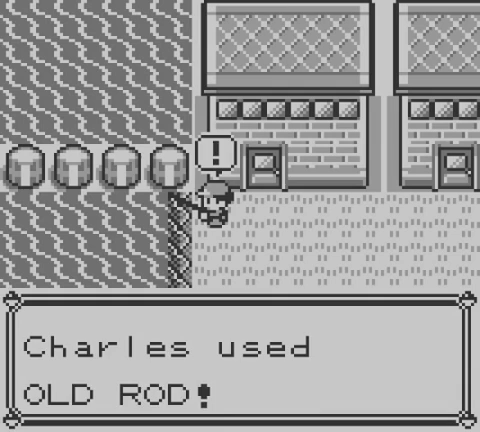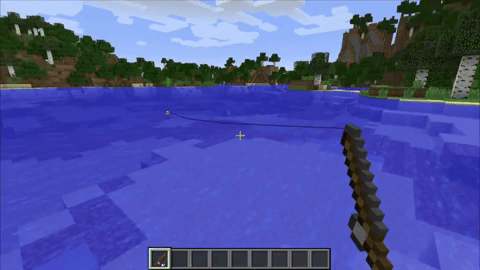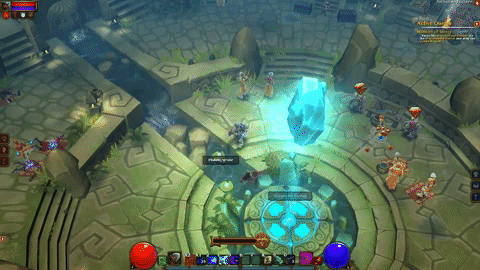Trending
Opinion: How will Project 2025 impact game developers?
The Heritage Foundation's manifesto for the possible next administration could do great harm to many, including large portions of the game development community.

Featured Blog | This community-written post highlights the best of what the game industry has to offer. Read more like it on the Game Developer Blogs or learn how to Submit Your Own Blog Post
Fishing is probably the most common mini-game in gaming history. So I tried to analyze for fun many of the possible variations in commercial game. How can we classify them? Can we create something new?

Fishing is probably the most common mini-game in gaming history. Before I started working on this article, I never realized how many games include fishing as mini-game. The list is huge. Fishing is everywhere. It seems that it is impossible to have a game without allowing the character to have a relaxing time fishing in a pond.
Everybody loves fishing! At least in games. We can imagine a deep reason for that. There must be something that attract designers, gamers and humans in general to the ancient art of fishing. However, for the time being, we are not interested in this question. Instead, we want to explore the huge design space of “fishing games”.
In fact, the action of fishing has been dissected for decades by game designers. It is fascinating to see how many implementations exist for the same real-life action. So, it is time to see what they produced, what are the possibilities and how we can do something new in this domain.

The first step of our game design effort is to find the experience we want to reproduce in our game. In particular, which emotions the original experience of fishing can give us and how we can transfer such emotions into our game.
The experience here is fishing. Fishing is associated with three basic emotions:
Serenity / Relaxation: The feeling of no fear. Just waiting along a river for a fish to bite.
Surprise: The feeling we have when we don’t know what we may get from fishing. Will we get a great fish or an old boot?
Excitement: Sometimes fishing provides excitement when the fish bite and we need to fight to catch them.
These are the three main emotional axes for the fishing experience. As we can see, we can use different game mechanics to pump any of these three axes. Obviously, in a fishing simulation game we want to capture all three emotions, but in a fishing mini-game, we may want to focus on just two emotions, or even one.

Every fishing mini-game can be divided in three phases:
Approach-Lure: the phase in which the player looks for the right spot and waits for the fish to bite. This is where the game builds up the serenity axis.
Bite: the transition phase between approach and catch. The player understands that the fish has bitten and must perform an action to start the next phase. This is where the game can build up the surprise and excitement axis.
Catch: the phase in which the player fights with the fish to actually grab it. This is where the game builds up the challenge and the excitement of fishing.
Different fishing mini-games implement these phases in different ways. There an infinite number of variations, however we can find some macro-categories for each phase.
Hidden: everything is hidden. There is no specific spot fishing. There is no visible fish to interact with. You just get a sudden notification on bait phase.
Visible: There is a clear indicator of the fish approaching the bait. We can have visibility in different intensity. We can see the real fish, we can see just the outline of the fish underwater, or just some abstract indicator (e.g., a circle approaching a bait symbol).
There is only one variation of this. Every bite mechanic is a timed event kind of action.
Automatic: often, once we get the bite in time, there is only the character animation and then the fish is caught. No more user interaction needed.
Button mashing: to have a simplified challenge mimicking the struggle of catching a baited fish, many games add a simplified “button mashing” step. Press a button very fast. Move the mouse in a certain way. Things like this.
Threshold Fight: the more “simulative” approach is to have the player engage in a battle with the fish. You increase the tension of the fishing line, you release tension, you tire the fish and you try to not break the line. As usual, this can be done in different intensities, from more arcade solution to more authentic experiences.
The above description identifies several potential fish mini-game macro-categories. In fact, we have a macro-category for each combination of different implementation for Approach, Bite and Catch.
It is time now to see real games with real fishing mini-games and see how they fit in this categorization.
This category is the easiest thing you can do with fishing. This is the way to go if you want a very simple fishing mechanic that provides a bit of relaxation and a full burst of surprise.

Pokemon is a great example of this. You use your rod, then, when the exclamation point pops up, you press a button and you catch something.

Shovel Knight also has a fishing mechanic. It is the same as Pokémon, as you can see.

Minecraft has fishing too. Throw your bait, wait for the lure to wobble and click with your mouse. Straightforwardly boring.
(video source)
This is a slightly more complex implementation, but still very easy and accessible. It is similar to Hidden-Auto, but the fact that it is possible to see the fishes, there is more “nature” to pump up a bit more of the relaxing feeling of fishing.
Another aspect: Because fish are usually visible, such games may implement an additional “luring” mechanic in which the player needs to move the bait in a certain way to attract the desired fish.
In the cases in which the actual fish is visible, obviously, we sacrifice a bit the “surprise” emotion.

Animal Crossing has a very relaxing fishing mechanic. It is not exciting but it is perfect for the game mood. You can see the shadow of the fish underwater. You aim your lure (aiming is something only games in the “visible” category can achieve) and, with the right time, you can get your fish.
(video source)

Torchlight 2's fishing mechanic is borderline. I put it in visible just because we have an abstract indicator of the fish (the circle around the bait) and you can fish only in specific spots. However, this is actually in between hidden and visible.
(video source)
Button Mashing mini-games (both visible and hidden) are a simple way to make your mini-game harder. It is similar to automatic category but, to catch the fish, the player must perform a brief endurance test. Press a button as fast as possible, move a motion controller quickly, or some other simple action.
This is a less relaxing experience. It also allows the designer to have different difficulties for different fishes by requiring more rapidly repeated actions.

Monster Hunter is a simple example of this. The implementation is very frustrating due to a horrible luring phase, but the button mashing step is well done and makes the players share the struggle of catching.
(video source)

In the Wii version, fishing in Twilight Princess is a fun experience. The luring part is well done and to catch, the player needs to wave the Wiimote to keep tension in the line.
(video source)
This is the most complex mechanic. However, the difficulty range goes from “minimal complexity” to “fishing simulator”. In order to catch something in these games, the player needs to keep focus in all the phases. Catching a fish is no mindless activity and you need to fight with your prey.

Fishing in Stardew Valley is hard. Baiting is hidden (so no luring problems), but to catch the fish you need to keep it in the green bar. The green bar goes up when pressing a button, and goes down when you press nothing. It is challenging and not very fun until you get better tools.
(video source)

Another hidden variant. However, this is much simpler than Stardew Valley. You just need to press A and release it when the fish is snapping the line.
(video source)

This is another hidden variant. However, the threshold fight is very original. Instead of a classic “press and release” input fight, the player need to perform some keyboard combo. If they fail, the fish get closer to escape, otherwise get closer to player inventory.
(video source)

Finally, as a visible example, The Legend of Zelda: Ocarina of Time. I’ll be honest. I totally forgot that there is a fishing section in Ocarina of Time. But there is, and it is magnificent.
The baiting step is visible, so you need to carefully move your bait to lure the fish. Then, you need to fight with a fish that is constantly trying to escape. It is an amazing implementation of a fishing mini-game.
(video source)
Now that we know the current state of fishing we can start asking ourselves the important questions: What we can do next? How can we improve this sub-genre? What we can do better? What works? Can we procedurally generate fishing mini-game rules?
I will try to answer these questions in the next part. In the meantime, I have question for you. What is your best fishing mini-game? Are there fishing mini-games that are not addressed by this categorization? Let me know.
This article has been originally published on my blog at this address. If you have any question, you can comment below or contact me on Twitter.
Read more about:
Featured BlogsYou May Also Like